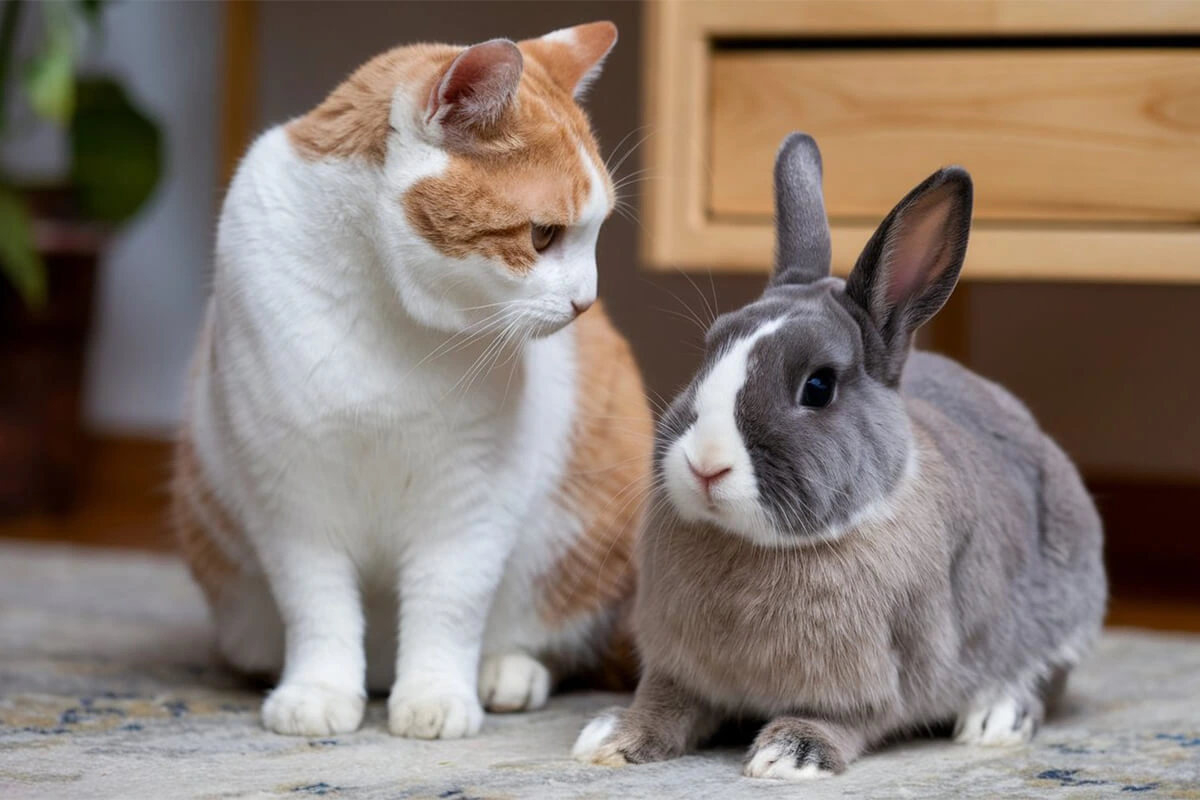Cats and bunnies may seem like an unlikely pair, but with the right approach, they can develop a strong and loving bond. The cat and bunny relationship depends on careful introductions, patience, and understanding their unique instincts. While cats are natural hunters and rabbits are prey animals, their differences don’t mean they can’t coexist peacefully. Many pet owners have successfully raised cats and rabbits together, proving that friendship between these two species is possible.
Building a healthy connection requires more than just placing them in the same room and hoping for the best. You need to consider factors like body language, socialization techniques, and safe introduction methods to ensure a positive experience for both pets. This guide will help you navigate the process, from the first introduction to maintaining a long-term friendship. Whether you’re thinking about bringing a bunny into a cat-friendly home or vice versa, understanding their behaviors and creating a safe environment will set the foundation for a happy and harmonious bond.
Can Cats and Bunnies Get Along?
Understanding Natural Instincts
Cats and bunnies have very different natural instincts, which can affect how they interact. A cat is a predator by nature, and its instincts drive it to chase small, fast-moving animals. On the other hand, a rabbit is a prey animal that relies on quick reflexes and hiding for survival. These instincts don’t mean a cat and bunny relationship is impossible, but they do require careful management.
A cat may see a rabbit as a potential playmate, but sometimes, its playful behavior can be too rough for a bunny. Rabbits use body language to communicate, which a cat might not always understand. A relaxed rabbit may stretch out on the floor, signaling comfort, but a cat might misinterpret this and pounce out of curiosity. Recognizing these natural instincts helps you create a safe environment and set the stage for a positive introduction.
Factors That Influence a Successful Relationship
Several factors determine whether a cat and bunny relationship will thrive. The temperament of both animals plays a major role. A calm and well-socialized cat is more likely to accept a rabbit, while an energetic or aggressive cat might struggle to coexist peacefully. Rabbits also have different personalities; some are confident and curious, while others are more timid. A bold rabbit may be more comfortable around a cat, while a shy one might feel constantly stressed.
Age and experience with other animals also matter. A kitten that grows up around a rabbit may see the bunny as part of its social group. Similarly, a rabbit raised around a cat may feel at ease. However, introducing an adult cat with a strong prey drive to a rabbit requires extra caution. Supervised interactions, gradual introductions, and positive reinforcement can help shape their relationship in a safe and controlled way.
Realistic Expectations for Bonding
Not every cat and bunny relationship will turn into a close friendship, and that’s okay. Some cats and rabbits tolerate each other without forming a strong bond, while others may become inseparable companions. As a pet owner, your goal should be to create a peaceful household where both animals feel safe and respected.
It’s important to understand that bonding takes time. Some pairs may warm up to each other quickly, while others might need weeks or even months to feel comfortable together. You should never force interactions or leave them alone unsupervised too soon. Even if they don’t cuddle or play together, a successful relationship means they coexist without stress or fear. Watching for signs of relaxation—like a rabbit grooming itself near a cat or a cat lying calmly in the same room—can indicate a growing trust between them.
With patience, proper introductions, and an understanding of their unique behaviors, a cat and bunny relationship can flourish. The key is to respect their differences, provide a secure environment, and let their bond develop at its own pace.
Introducing a Cat to a Bunny: The Right Way
Preparing a Safe Space for Introductions
Creating a safe environment is the first step in building a successful cat and bunny relationship. Before the first meeting, you need to set up a controlled space where both pets feel secure. Rabbits are naturally cautious animals, and a sudden introduction to a cat can cause unnecessary stress. Likewise, a cat might become overly excited or territorial if the meeting isn’t handled properly.
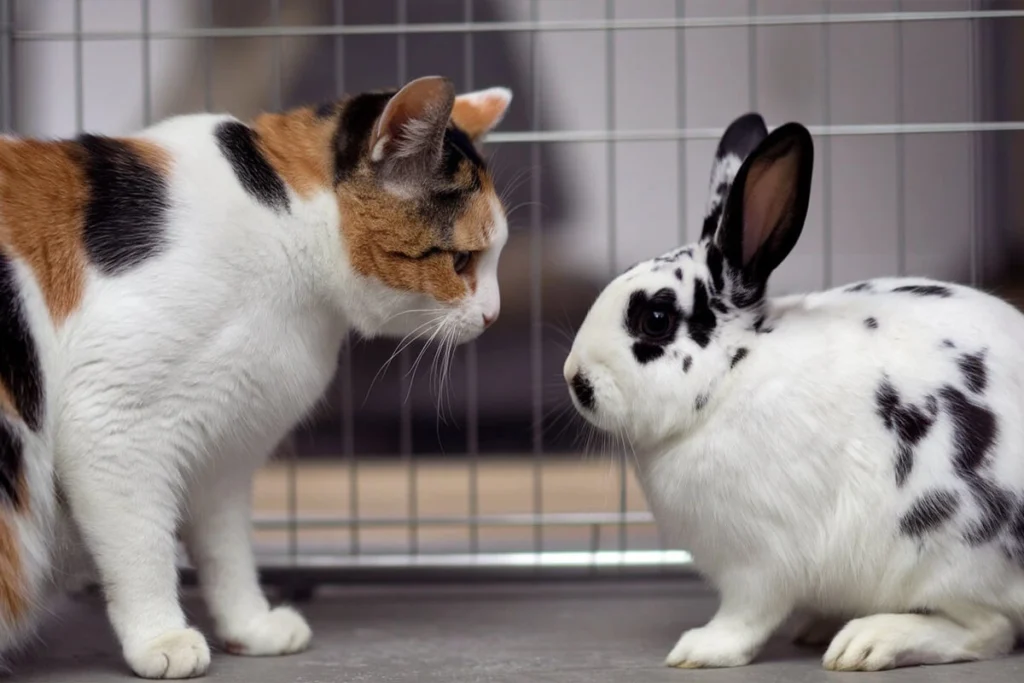
Choose a neutral area where neither pet feels a strong sense of ownership. Avoid introducing them in a space where your cat frequently sleeps or where your rabbit already roams freely. A playpen, a baby gate, or a large enclosure can serve as a physical barrier, allowing them to see and smell each other without direct contact. Make sure both animals have an escape route or a hiding spot. A rabbit should always have access to a hiding box, while a cat should be able to retreat to a perch or a high shelf if needed.
Start by letting your cat and rabbit get used to each other’s scent before their first face-to-face meeting. Swap bedding, place a cloth with one pet’s scent in the other’s space, and allow them to sniff around. This process helps reduce anxiety and makes their introduction feel more familiar and less threatening.
Step-by-Step Guide to a Slow and Controlled Meeting
A cat and bunny relationship requires patience, and rushing their first meeting can create long-term fear or tension. Follow these steps for a smooth introduction:
- First Visual Introduction: Keep them separated by a pet gate or a playpen so they can observe each other without physical contact. Watch how both react—curiosity is a good sign, while hissing, lunging, or thumping (from the rabbit) signals discomfort.
- Short and Supervised Sessions: Once both pets seem calm, allow brief, controlled interactions in the same space while keeping your cat on a leash or harness. Let your rabbit move freely while monitoring their body language.
- Use Positive Reinforcement: Reward both animals with treats and gentle praise whenever they remain calm. This helps them connect with each other in a good way.
- Increase Interaction Gradually: Extend their time together little by little, but always supervise. If either pet shows signs of aggression or extreme fear, separate them and try again later.
- Never Force Interaction: Some cats and rabbits take days or weeks to feel comfortable, while others might need months. Respect their pace and let their comfort levels guide the process.
Signs of Stress vs. Signs of Curiosity
Understanding the difference between curiosity and stress is key to developing a positive cat and bunny relationship. Both pets use body language to express their emotions, and recognizing these signals helps you determine when to continue or pause the bonding process.
Signs of Curiosity (Positive Reactions)
- Cat sits and watches the rabbit without showing aggression
- Rabbit approaches the cat with ears relaxed and body at ease
- Gentle sniffing or nose-touching between the two
- Both animals remain calm and don’t try to run away
Signs of Stress or Discomfort (Negative Reactions)
- Cat’s tail flicking aggressively, ears pinned back, or sudden lunging
- Rabbit thumping its hind legs, freezing in place, or running for cover
- Hissing, growling, or excessive stalking from the cat
- Rapid breathing or wide eyes in either animal
If you notice signs of stress, slow down the process and give both pets more time to adjust. Forcing interactions can damage trust and make future bonding more difficult. A successful cat and bunny relationship develops naturally when both animals feel safe and comfortable in each other’s presence.
Bonding a Cat and a Rabbit: Strengthening Their Friendship
Positive Reinforcement and Socialization Techniques
Building a strong cat and bunny relationship requires patience, trust, and positive reinforcement. Both cats and rabbits need to feel safe in each other’s presence before they can form a bond. Using positive reinforcement helps encourage good behavior and makes their interactions more enjoyable.
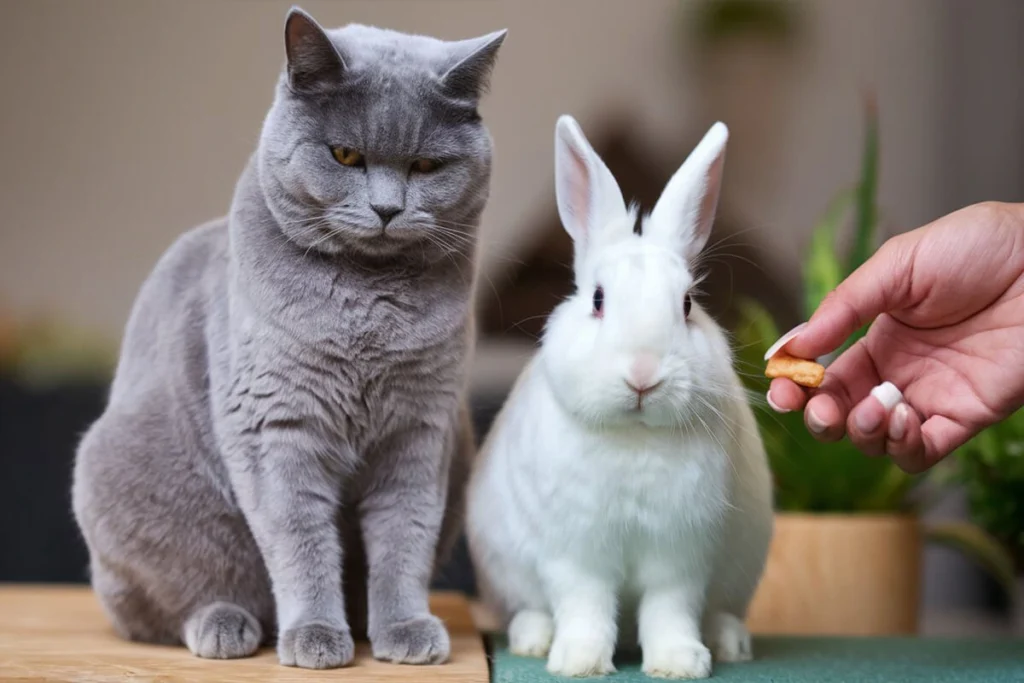
Whenever your cat and rabbit remain calm near each other, reward them with treats and gentle praise. Cats respond well to small pieces of their favorite treats, while rabbits enjoy fresh veggies like parsley or a small piece of banana. This teaches them that being around one another brings positive experiences.
Avoid scolding or using negative reinforcement if either pet reacts nervously or shows hesitation. Instead, redirect unwanted behavior by creating distance or offering a distraction. If your cat seems overly focused on the rabbit, use a toy to engage its attention. If your rabbit appears tense, give it time to retreat and relax before trying again. Over time, these small positive interactions help strengthen their bond and create a stress-free environment.
Encouraging Gentle Interactions and Supervised Playtime
Playtime plays a major role in developing a healthy cat and bunny relationship, but it must be carefully managed. While some cats and rabbits eventually learn to play together, their play styles are very different. Cats enjoy pouncing, chasing, and using their paws, while rabbits prefer hopping, nudging, and zooming around. If not monitored, a cat’s natural playfulness can become overwhelming or even dangerous for a rabbit.
Start by supervising all interactions closely. Choose a calm, enclosed space where both pets feel secure. Provide toys that encourage gentle engagement, such as tunnels for the rabbit and soft balls or wand toys for the cat. Watch their reactions—if the rabbit seems comfortable moving around the cat and the cat remains relaxed without attempting to pounce, it’s a good sign that they are getting used to each other.
If your cat tries to chase the rabbit, discourage the behavior by redirecting its attention to a toy. If your rabbit starts thumping or running away, it may feel unsafe, so it’s best to separate them and try again later. Some cats and rabbits eventually develop playful behaviors together, like hopping side by side or gently nudging each other, but this process happens gradually. Keeping their interactions positive and controlled helps them build trust over time.
Recognizing and Respecting Their Boundaries
Not every cat and bunny relationship will lead to constant companionship, and that’s perfectly okay. Some cats and rabbits prefer to coexist peacefully without engaging in direct play, while others become inseparable. The key to a successful bond is respecting their boundaries and allowing their relationship to develop naturally.
Both animals have unique ways of setting boundaries. If a rabbit feels uncomfortable, it may freeze, hop away, or thump its back legs. If a cat feels uneasy, it might flick its tail, lower its ears, or walk away. Recognizing these signals helps prevent stress and avoids forcing interactions that could harm their trust.
Provide separate spaces where both pets can retreat when they need alone time. Rabbits enjoy enclosed spaces like hideouts or covered areas, while cats prefer perches or quiet corners. Allowing them to have independent spaces ensures they feel secure and reduces the risk of conflict.
With patience and respect for their personalities, a cat and bunny relationship can flourish. Some pairs develop a close friendship, while others are simply comfortable sharing the same space. As long as both pets feel safe and relaxed, their bond—no matter the form—will be a success.
How to Keep Cats and Rabbits Together Safely
Creating a Multi-Pet Household That Works for Both
A cat and bunny relationship can thrive in a multi-pet household, but it requires careful planning to ensure both animals feel comfortable. Cats and rabbits have different needs, and balancing their living arrangements helps create a peaceful and harmonious home.
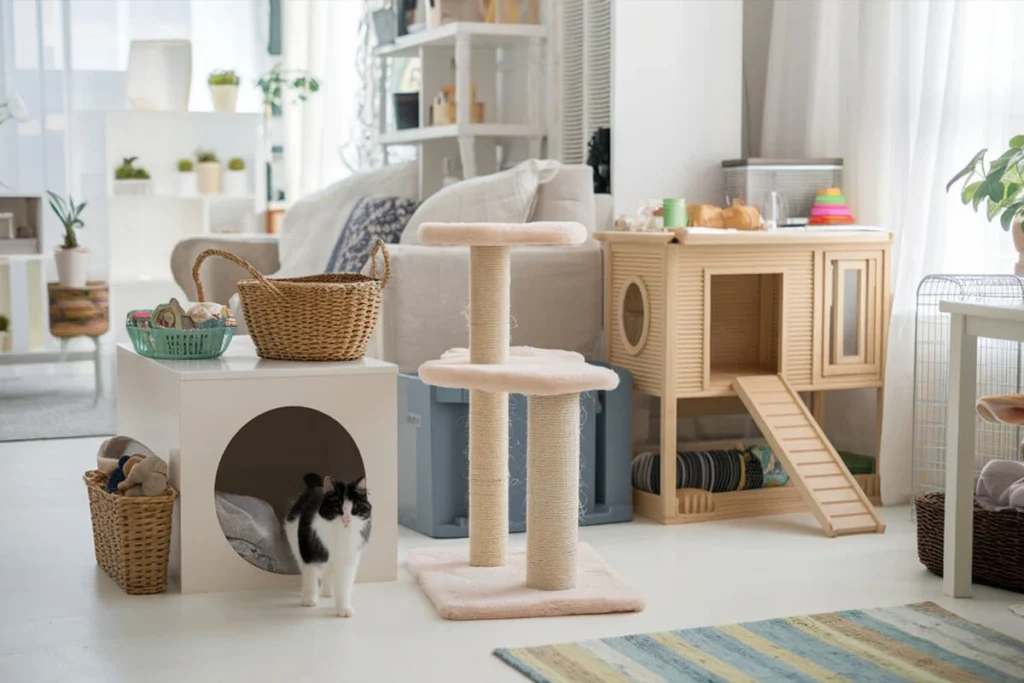
Start by considering their personalities. A laid-back cat that doesn’t have a strong prey drive is more likely to get along with a rabbit. Similarly, a confident rabbit that doesn’t startle easily will adjust better to living with a cat. If either pet seems fearful or overly dominant, their relationship may take longer to develop.
Introduce a routine that accommodates both pets. Rabbits are crepuscular, meaning they are most active during dawn and dusk, while cats can be active at different times depending on their environment. Setting a consistent feeding, playtime, and resting schedule ensures that neither pet feels neglected and reduces potential conflicts.
It’s also important to supervise their interactions, especially in the beginning. While some cats and rabbits learn to coexist without issues, others may need long-term management to maintain a peaceful relationship. Observing their behavior helps you identify what works best for your unique multi-pet household.
Providing Separate Spaces for Security and Comfort
Even if a cat and bunny relationship is friendly, both pets need their own space to feel safe. Rabbits, in particular, require a secure area where they can retreat without fear of being disturbed. Since rabbits are prey animals, they feel safest in enclosed spaces like hideouts, tunnels, or covered resting spots.
A rabbit’s enclosure should be large enough to allow comfortable movement, with a hiding box where it can escape if it feels threatened. The enclosure should also have a top cover if your cat is particularly curious. This prevents the cat from jumping in and invading the rabbit’s safe space.
Similarly, cats need their own areas to relax. Many cats enjoy high perches, window ledges, or cat trees where they can observe their surroundings without feeling vulnerable. Giving your cat vertical spaces ensures it doesn’t feel like it has to compete with the rabbit for territory.
Separate feeding areas are also crucial. Cats and rabbits have different dietary needs, and they shouldn’t have access to each other’s food. Rabbits may nibble on cat food, which is harmful to them, while some cats might show interest in rabbit pellets or vegetables. Keeping their meals in designated spaces prevents health issues and reinforces their boundaries.
Managing Playtime and Preventing Conflicts
Playtime strengthens a cat and bunny relationship, but their play styles are different, so careful supervision is essential. Cats are natural hunters, and even a friendly cat might instinctively chase a running rabbit. Rabbits, on the other hand, express excitement through zooming and hopping, which can trigger a cat’s chasing instinct.
Encourage gentle interactions by choosing activities that allow both pets to engage without stress. Use interactive toys, tunnels, or treat-dispensing puzzles to keep them entertained while preventing rough play. If your cat shows signs of wanting to chase, redirect its attention to a wand toy or a ball.
Watch for warning signs that indicate tension. A rabbit thumping its hind legs or freezing in place means it feels unsafe, while a cat flicking its tail aggressively or crouching low might be preparing to pounce. If either pet looks uncomfortable, separate them immediately and give them time to relax before trying again.
Never leave them alone together until you are confident that their interactions are safe. Some cats and rabbits form close bonds and even nap next to each other, while others prefer to keep a respectful distance. Regardless of how their relationship develops, ensuring both pets feel secure and stress-free is the key to a successful multi-pet household.
Signs of a Happy Pet Bond
Understanding Rabbit Body Language and Cat Behaviors
To build a strong cat and bunny relationship, you need to understand how each pet communicates. Cats and rabbits use body language to express their emotions, but because their signals are different, misinterpretations can happen. Recognizing their behaviors helps you ensure their interactions are positive and stress-free.
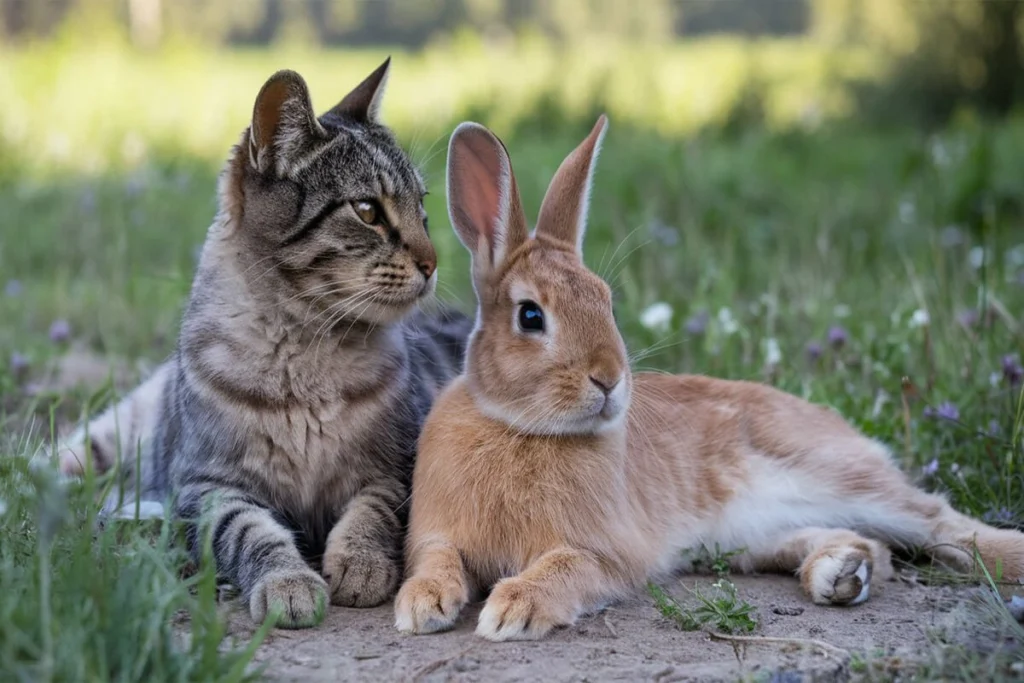
Rabbit Body Language:
- Relaxed posture: A happy rabbit may flop onto its side, stretch out, or lounge comfortably in its space.
- Binkying: This joyful, mid-air twist and jump shows pure excitement. If your rabbit binkies near your cat, it’s a great sign of trust.
- Gentle nudging: A rabbit may nudge your cat as a sign of curiosity or affection.
- Thumping: A loud thump with the hind legs signals fear or annoyance. If your rabbit thumps when your cat is near, it might be feeling unsafe.
Cat Behaviors:
- Slow blinking: If your cat looks at your rabbit and slowly blinks, it’s a sign of trust and relaxation.
- Curious sniffing: Cats use their noses to gather information. If your cat gently sniffs the rabbit without swiping or lunging, it’s likely feeling friendly.
- Tail position: A high, gently swaying tail indicates happiness, while a flicking or puffed-up tail can mean excitement or irritation.
- Pouncing or stalking: If your cat crouches low and watches the rabbit with dilated pupils, it may be in hunting mode. Always intervene if this happens.
By observing these behaviors, you can gauge how comfortable your pets are with each other and adjust their interactions as needed.
How to Tell if Your Cat and Rabbit Enjoy Each Other’s Company
A successful cat and bunny relationship doesn’t always mean they will cuddle or play together. Some pairs develop a close friendship, while others are simply comfortable coexisting in the same space. Knowing the signs of a positive bond helps you determine if your pets are happy together.
Signs of a Good Relationship:
- Calm coexistence: If your cat and rabbit can be in the same room without stress or fear, they’ve developed a healthy level of trust.
- Proximity without tension: A rabbit that relaxes near a cat and a cat that doesn’t react aggressively or territorially shows mutual acceptance.
- Grooming: If a rabbit licks a cat’s fur or a cat gently licks a rabbit, it’s a sign of affection and bonding.
- Shared spaces: Some cats and rabbits will nap near each other or choose to hang out in the same area.
Signs of Discomfort or Conflict:
- Avoidance: If one pet constantly moves away from the other, it may feel uneasy.
- Overexcitement: If your cat gets too playful and the rabbit seems nervous, the interaction needs to be slowed down.
- Chasing or stalking: If a cat persistently stalks or chases the rabbit, it’s a sign that its hunting instincts are too strong, and they shouldn’t be left alone together.
When to Help and When to Stay Out of It
A cat and bunny relationship should develop naturally, but as a pet owner, you need to know when to step in and when to let them work things out on their own.
When to Intervene:
- If your cat displays hunting behavior: Stalking, pouncing, or aggressive tail flicking means your cat might see the rabbit as prey. Redirect its attention immediately.
- If the rabbit thumps or runs away: These are signs of fear, and forcing interaction will only increase stress. Give the rabbit time to feel safe again.
- If chasing turns aggressive: Some playful chasing is normal, but if the cat starts swiping or the rabbit appears panicked, separate them.
- If either pet shows territorial behavior: If your cat starts guarding areas or your rabbit becomes defensive, they need separate spaces for a while.
When to Let Them Be:
- If they are calmly in the same space: If neither pet is showing stress signals, let them get used to each other naturally.
- If they show curiosity: Gentle sniffing, watching each other from a distance, or slow movements indicate that they are learning to trust one another.
- If small positive interactions happen: If your rabbit hops over to sit near the cat or your cat softly blinks at the rabbit, it’s a good sign that their bond is growing.
Every cat and bunny relationship is unique, and their bond will develop at its own pace. The key is to monitor their behavior, encourage gentle interactions, and respect their individual comfort levels. With patience and care, they can learn to live together peacefully—whether as best friends or simply as housemates who respect each other’s space.
Conclusion: Building a Strong and Loving Cat and Bunny Relationship
Creating a successful cat and bunny relationship takes time, patience, and a deep understanding of both animals’ needs. Cats and rabbits come from different worlds—one is a natural predator, and the other is a prey animal. However, with proper introductions, socialization, and ongoing supervision, they can learn to coexist peacefully and even form a close bond.
Respecting their natural instincts plays a crucial role in ensuring a positive relationship. Understanding rabbit body language and cat behaviors helps you recognize whether they feel comfortable, curious, or stressed in each other’s presence. Positive reinforcement, slow introductions, and creating safe spaces allow both pets to build trust at their own pace.
Some cat and bunny relationships lead to deep companionship, where they groom each other and enjoy being close. Others result in mutual respect, where they share the same space without direct interaction. Both outcomes are signs of a successful bond as long as neither pet feels fear or stress.
Always monitor their interactions, especially in the early stages. Encourage gentle behaviors, provide separate spaces for security, and prevent conflicts before they arise. Never force their friendship—letting them set their own boundaries leads to a healthier, more natural bond.
With time, patience, and proper guidance, your cat and rabbit can live in harmony. Whether they become best friends or simply coexist peacefully, a well-managed cat and bunny relationship creates a loving and balanced multi-pet household where both animals feel safe and happy.
Pick The Cutest Name for your Cat Or Bunny From our Top 20 Cute Names Here.
Find The Best Care Tips For All Different Cats From HERE.
Looking For Some Good stuff for your Pet? Look no Further and pay Pet MD Official a Visit.
